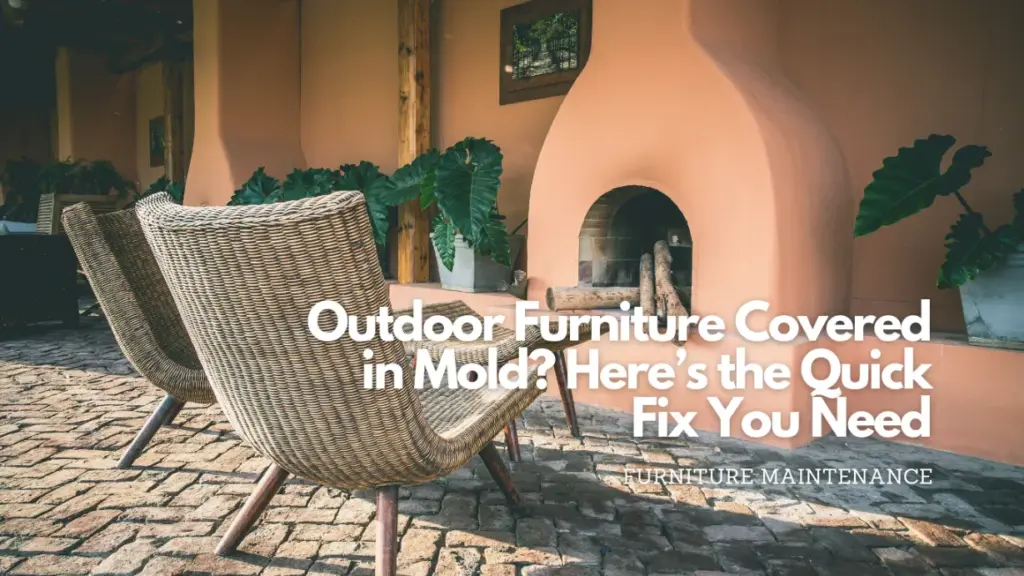Outdoor Furniture Covered In Mold Here’s The Quick Fix You Need
Outdoor furniture adds charm, comfort, and style to patios, gardens, and decks. But without proper furniture maintenance, these pieces can quickly lose their beauty. One of the most common issues homeowners face is mold growth. Mold thrives in damp, humid environments, making wooden chairs, fabric cushions, and even metal furniture vulnerable. Left untreated, mold not only looks unsightly but can also weaken your furniture and even trigger health problems.
The good news? Mold doesn’t mean the end of your outdoor set. With the right cleaning methods, tools, and preventive measures, you can restore your furniture’s look and extend its life.
In this guide, we’ll show you why mold forms, how to safely remove it using four proven methods, and what preventive strategies to apply for long-term protection. Whether your furniture is wood, plastic, or fabric, these quick fixes will help you keep it fresh and mold-free all year round.
Table of Contents
Why Does Mold Grow on Outdoor Furniture?
Mold spores are everywhere. When combined with moisture, warmth, and poor ventilation, they spread quickly especially outdoors. Patio furniture is a prime target because it’s constantly exposed to rain, humidity, and morning dew.
Common causes of mold growth on furniture:
- Moisture buildup: Rainwater or condensation that isn’t dried properly.
- Organic material: Wood, wicker, and even fabric cushions contain natural fibers mold feeds on.
- Shade and lack of airflow: Furniture placed in damp corners with little sunlight is more prone to infestation.
- Improper storage: Covering or stacking damp furniture without drying it out first.
Ignoring mold allows it to penetrate deeper, causing permanent stains, unpleasant odors, and potential respiratory risks for your family.
Tip: Regular furniture maintenance such as cleaning and sealing reduces the chances of mold growth significantly.
Furniture Maintenance: Tools and Supplies You’ll Need
Before starting, gather these essentials:
- A bucket of warm water
- Mild dish soap or white vinegar
- Baking soda (for stubborn stains)
- Soft-bristle brush or sponge
- Microfiber cloths
- Rubber gloves and mask
- Optional: commercial mold cleaner for outdoor furniture
Having everything ready makes the cleaning process quicker and more efficient.
Method 1: Soap and Water
The simplest fix is often the best. Mix a few drops of dish soap with warm water. Dip a sponge or soft brush into the solution and scrub affected areas gently. Rinse with clean water and let the furniture dry in direct sunlight.
Best for: light mold spots on plastic, wicker, furniture.
Method 2: Vinegar Solution
White vinegar is a natural disinfectant that kills up to 80% of mold species. Mix equal parts white vinegar and water in a spray bottle. Spray generously on the moldy surface and let it sit for 15–20 minutes. Scrub with a brush, rinse, and dry.
Best for: wooden furniture and fabric cushions.
Always spot-test first vinegar may slightly alter finishes.
Method 3: Baking Soda Paste
For stubborn patches, baking soda is both abrasive and deodorizing. Mix baking soda with a little water until you form a paste. Apply it to the mold, scrub gently, and rinse off. Repeat if needed.
Best for: outdoor tables, benches, and fabrics with lingering odors.
Method 4: Commercial Mold Cleaner
If natural solutions don’t work, use a furniture-safe mold remover. Follow the manufacturer’s instructions and always wear gloves and a mask. After cleaning, rinse thoroughly and allow the furniture to dry.
Best for: heavily infested or long-neglected furniture.
Preventing Mold in the Future
Removing mold is one part of furniture maintenance prevention is the other. Protect your outdoor pieces with these tips:
- Keep furniture dry: Wipe down after rain or humidity.
- Use protective covers: Choose breathable, waterproof covers to shield from rain while avoiding trapped moisture.
- Store properly: During wet seasons, move furniture into a shed or garage.
- Seal wooden furniture: Apply sealants like tung oil or polyurethane to create a water-resistant layer.
- Place strategically: Keep furniture in areas with good sunlight and airflow.
Pro tip: Add regular deep-cleaning sessions to your furniture maintenance routine twice a year is ideal.
Mold doesn’t have to ruin your outdoor setup. With soap, vinegar, baking soda, or a commercial cleaner, you can remove mold quickly and safely. Prevention is key keeping your furniture dry, sealed, and properly stored will make a huge difference.
Explore more care guides: Cutting Board Maintenance, and Wooden Bed Frame Restoration.
For expert DIY tips and exclusive maintenance tricks, sign up for our Wooden Edge Studios newsletter today and keep your furniture looking its best all year round!

